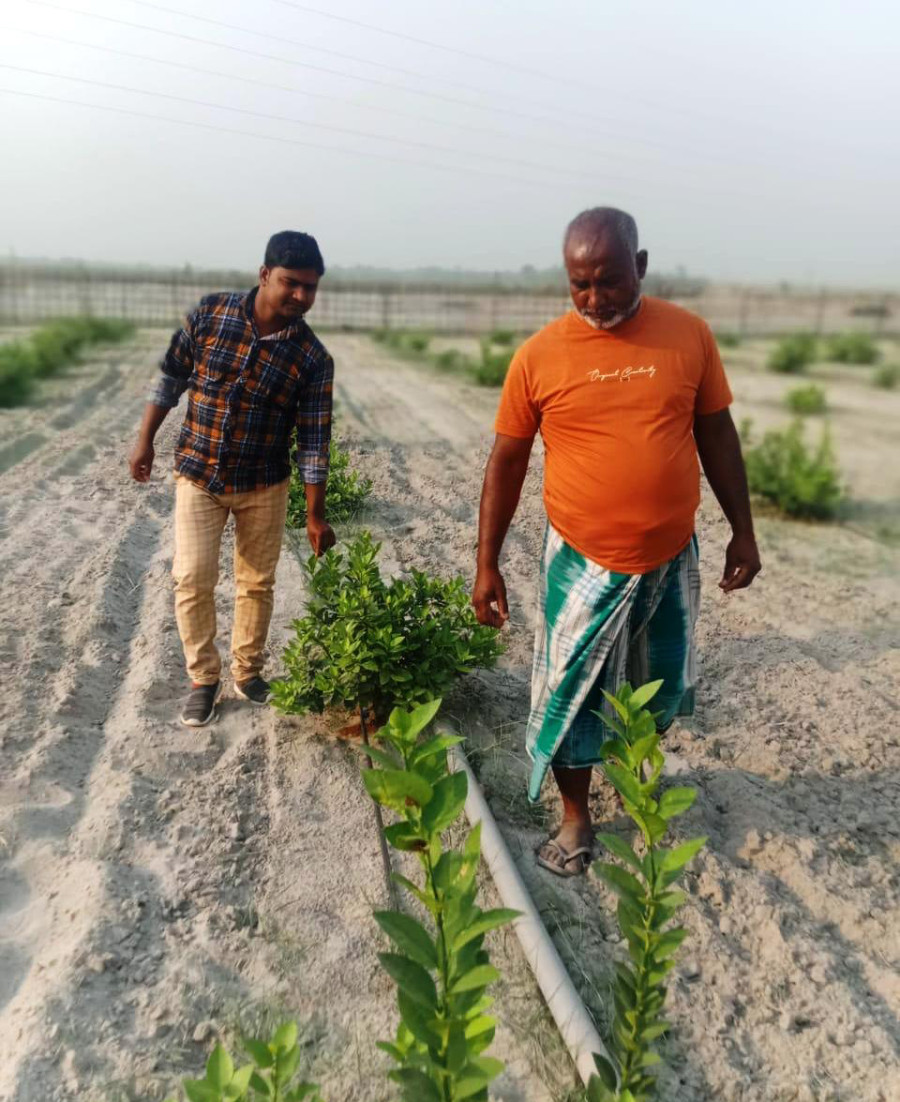Money
Farmers who lost fertile lands to Koshi floods find hope in fruit farming
Villagers learn new techniques to turn sand covered land into fruit orchards.
Pradeep Menyangbo
On August 18, 2008, the Koshi River burst through its eastern embankment about 13 km upstream from the Koshi Barrage. Sahabuddin Haq, who has a farm on the banks of the wayward river, was ruined when his field was buried under 4 feet of sand.
The Koshi rushed over the plains, the water flow swelling to 166,000 cubic feet per second (cusec) from the regular 25,744 cusecs, and carved a new path 15-20 km wide and 150 long north to south.
The flood spread across eastern Nepal and India, and thousands of people lost their possessions. The water eventually receded, but it left behind a devastated land.
Hectares of fertile farmland turned into desert overnight. In Koshi Rural Municipality alone, 3,100 bighas (500 hectares) of land was covered with sand.
Seeing no hope of being able to grow anything on the land, most young people of Kumyahi Ghorki village in Koshi Rural Municipality-5 in Sunsari district decided to go abroad for work, many went to India.
Haq too joined the exodus. He left for Qatar in 2010—two years after the flood inundated his village. He spent nearly nine years in the Gulf country before returning home. He was 27 years old.
Haq tried to sell his 4-bigha farm, but there were no buyers. “The land was useless. A barren desert,” he said.
The villagers had no idea what they were going to do. Nobody would buy their land, and the bank would not lend them any money with it as collateral.
Then their luck changed. They learnt to make green plants grow in the swathes of sand. Haque had planted 550 lemon saplings on his land a year ago, and they were starting to bear fruit. He has also planted dragon fruit.
Haq expects to earn Rs2.5 annually from his lemon trees in the next five years. His farm has also become a destination for agro tourism.
“More than 2,000 Indian farmers have visited my farm,” he said. “People are really surprised to see lemon growing out of the sand.”
Haq's neighbour Asgar Ali has also become a lemon farmer. The two had seen a video on YouTube how lemon could be grown in sand. They took the idea to Koshi Rural Municipality which arranged a study visit to Rajasthan state in India.
A 10-member municipality team led by Chairman Ayub Ansari went to Rajasthan where they held an interaction at the Department of Agriculture and observed some sites. The farming model was replicated on the banks of the Koshi River.
Other farmers like Mohammad Ison, Enamul Haq, Arwin Yadav and Jalaumuddin Haq have also started cultivating lemon, dragon fruit, squash, pomegranate and watermelon.
“I have 15 bighas of land all covered with sand. This year, I planted lemon and dragon fruit on 1 bigha. The lemon trees have started bearing fruit,” Ali said.
The value of the land here is going up now. The desert has been drawing many farmers. Haq said that people were not willing to buy his land for even Rs20,000 per kattha two years ago.
“Now the land is worth Rs250,000 per kattha. None of the farmers, including me, will sell the land. We have realised that the desert is not a wasteland anymore.”
In many countries, farming in the desert is expensive as the farm requires water regularly. Desert farms require almost three times more water than those in temperate climates. This makes farming in the desert impractical.
But growing plants in sand is different, said farmers who have learned the Rajasthani model. According to them, a small ditch needs to be dug and filled with organic manures to plant the sapling. The plant needs to be watered regularly.
For Ali, who owns 15 bighas of land, life was once difficult. He had to face difficulties as his source of income dried up completely after the Koshi flood.
Ali was not able to enrol his children in school due to financial difficulties. When his two sons grew up, they had to go abroad as migrant workers. Ali had even worked as a daily wage earner.
“If modern irrigation facilities are provided, our productivity could be higher than in Rajasthan,” said Ali, who was a member of the study group. “In Rajasthan, a lemon plant bears fruits for 30 years.”
Ali is now optimistic. “I am preparing to utilise other land that was left barren for years,” he said.
The Koshi flood had affected 35,000 households in the then four village development committees—Shreepur, Haripur, Paschim Kushwaha and Laukahi.
Some farmers who could afford it had spent up to Rs150,000 to have the sand removed from their fields and started cultivating paddy, corn, wheat and barley.
But productivity has not improved. For many farmers, it was already too late to remove the sand, and now it costs a lot of money to do so.
According to Ayub Ansari, chairman of the rural municipality, sand has been removed from 600 bighas of land, but more than 2,500 bighas is still covered by it.
“It’s now impossible to remove the sand. But farmers have learned a new technique after the visit to Rajasthan,” he said.
Ansari said that the federal and provincial governments should help to market the lemon, dragon fruit, Indian plum, pointed gourd, peanut and pomegranate crops produced by the local farmers.
“Thousands of farmers in Koshi Rural Municipality will benefit if proper market access is provided.”




 5.62°C Kathmandu
5.62°C Kathmandu















